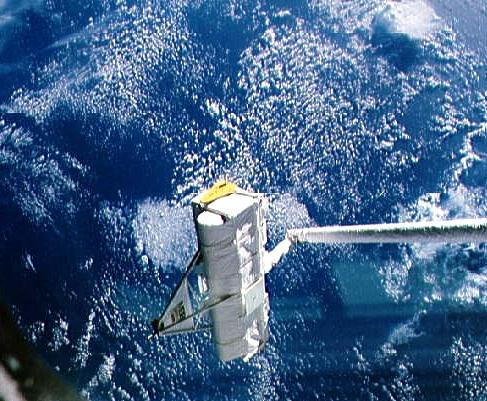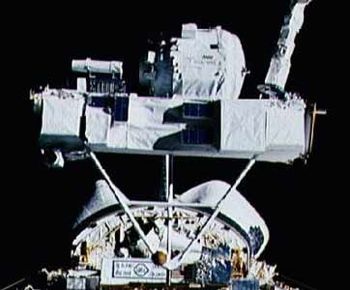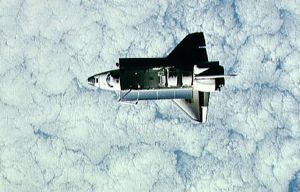
Home - Search - Browse - Alphabetic Index: 0- 1- 2- 3- 4- 5- 6- 7- 8- 9
A- B- C- D- E- F- G- H- I- J- K- L- M- N- O- P- Q- R- S- T- U- V- W- X- Y- Z
SPAS

STS-7
Challenger's RMS arm grasps SPAS-01 during proximity operations
Credit: NASA
AKA: Shuttle Pallet Satellite. Status: Operational 1983. First Launch: 1983-06-18. Last Launch: 1997-08-07. Number: 6 . Gross mass: 3,230 kg (7,120 lb).
The SPAS (Shuttle Pallet Satellite) satellite was a reusable free-flying vehicle built by Messerschmitt-Bolkow-Blohm, which could be deployed and then retrieved by the US Space Shuttle's Remote Manipulator System arm.
The original SPAS, with materials processing and SDI-related sensor payloads, was used on several missions (STS-7, STS-11, STS-39). An experiment-carrying truss (USS) based on the original SPAS structure (but without the avionics and attitude control) was flown on the Spacelab D-1 and D-2 missions.
ORFEUS-SPAS, the Orbiting and Retrievable Far and Extreme UV Spectrometer, was a German astronomical satellite. It was be deployed by the shuttle remote manipulating system arm and retrieved after six days of free flight. The main instrument was a 1 meter telescope with extreme ultraviolet (400-1150 Angstroms) and far ultraviolet (900-1250 Angstrom) spectrometers of high spectral resolution. Also carried was the Princeton Interstellar Medium Absorption Profile Spectrograph which studied the fine structure of ultraviolet absorption lines in stellar spectra caused by interstellar gas. The ORFEUS program was managed by the German space agency.
CRISTA-SPAS, equipped for observation of the earth's atmosphere, was flown on two missions.
More at: SPAS.
| STS-66 Carried Atlas-3 laboratory; deployed and retrieved CRISTA-SPAS. |
| STS-85 Deployed and retrieved the CRISTA-SPAS-2 (the Cryogenic Infrared Spectrometers and Telescopes for the Atmosphere-Shuttle Pallet Satellite-2) designed to study Earth's middle atmosphere. |
Family: Astronomy, Earth, Military, Military strategic defense sat. Country: USA. Launch Vehicles: Space Shuttle. Launch Sites: Cape Canaveral, Cape Canaveral LC39A, Cape Canaveral LC39B. Agency: MBB. Bibliography: 2, 276, 279, 4, 6, 7, 6926.
 | CRISTA-SPAS Credit: Manufacturer Image |
 | IBSS-SPAS Credit: Manufacturer Image |
 | ORFEUS-SPAS Credit: Manufacturer Image |
 | SPAS-01 Credit: Manufacturer Image |
 | STS-7 Full view of Challenger in space taken by the SPAS satellite Credit: NASA |
 | STS-7 Full views of Challenger in space taken by the SPAS satellite Credit: NASA |
 | STS-7 Full views of Challenger in space taken by the SPAS satellite Credit: NASA |
1983 June 18 - . 11:33 GMT - . Launch Site: Cape Canaveral. Launch Complex: Cape Canaveral LC39A. Launch Platform: MLP1. LV Family: Shuttle. Launch Vehicle: Space Shuttle.
- SPAS-01 - .
Payload: Challenger F2 / SPAS 1. Mass: 3,230 kg (7,120 lb). Nation: USA.
Agency: MBB.
Class: Military.
Type: Strategic defense satellite. Spacecraft Bus: Shuttle Attached Payloads.
Spacecraft: SPAS.
Decay Date: 1983-06-22 . USAF Sat Cat: 14142 . COSPAR: 1983-059F. Apogee: 300 km (180 mi). Perigee: 295 km (183 mi). Inclination: 28.50 deg. Period: 90.50 min.
Ten experiments mounted on Shuttle Pallet Satellite (SPAS-01) performed research in forming metal alloys in microgravity and use of remote sensing scanner. Orbiter's small control rockets fired while SPAS-01 held by remote manipulator system to test movement on extended arm.
1984 February 3 - . 13:00 GMT - . Launch Site: Cape Canaveral. Launch Complex: Cape Canaveral LC39A. Launch Platform: MLP2. LV Family: Shuttle. Launch Vehicle: Space Shuttle.
- SPAS 1A - . Mass: 3,230 kg (7,120 lb). Nation: USA. Agency: NASA. Class: Military. Type: Strategic defense satellite. Spacecraft Bus: Shuttle Attached Payloads. Spacecraft: SPAS. Decay Date: 1984-02-11 . USAF Sat Cat: 14681 . COSPAR: 1984-011xx. Apogee: 294 km (182 mi). Perigee: 270 km (160 mi). Inclination: 28.60 deg. Period: 90.20 min. German-built Shuttle Pallet Satellite (SPAS), first flown on STS-7, became first satellite refurbished and flown again. SPAS remained in payload bay due to electrical problem with Remote Manipulator System (RMS)..
1991 April 28 - . 11:33 GMT - . Launch Site: Cape Canaveral. Launch Complex: Cape Canaveral LC39A. Launch Platform: MLP2. LV Family: Shuttle. Launch Vehicle: Space Shuttle.
- SPAS-II - . Payload: SPAS. Mass: 3,230 kg (7,120 lb). Nation: USA. Agency: NASA. Class: Military. Type: Strategic defense satellite. Spacecraft Bus: Shuttle Attached Payloads. Spacecraft: SPAS. COSPAR: 1991-031xx. Apogee: 263 km (163 mi). Perigee: 248 km (154 mi). Inclination: 57.00 deg. Period: 89.60 min. Shuttle Pallet Satellite-II (SPAS-II) experiments were carried out on this classified mission. No details on whether SPAS was released or nature of experiments..
1993 September 12 - . 11:45 GMT - . Launch Site: Cape Canaveral. Launch Complex: Cape Canaveral LC39B. Launch Platform: MLP3. LV Family: Shuttle. Launch Vehicle: Space Shuttle.
- ORFEUS-SPAS - . Payload: ASTRO-SPAS 01. Mass: 3,202 kg (7,059 lb). Nation: USA. Agency: DARA. Class: Astronomy. Type: X-ray astronomy satellite. Spacecraft Bus: Shuttle Attached Payloads. Spacecraft: SPAS. Decay Date: 1993-09-22 . USAF Sat Cat: 22798 . COSPAR: 1993-058C. Apogee: 331 km (205 mi). Perigee: 301 km (187 mi). Inclination: 28.50 deg. Period: 90.90 min. Deployed from STS-51..
1994 November 3 - . 16:59 GMT - . Launch Site: Cape Canaveral. Launch Complex: Cape Canaveral LC39B. Launch Platform: MLP3. LV Family: Shuttle. Launch Vehicle: Space Shuttle.
- CRISTA-SPAS - . Mass: 3,260 kg (7,180 lb). Nation: Germany. Agency: DLR. Class: Earth. Type: Atmosphere satellite. Spacecraft Bus: Shuttle Attached Payloads. Spacecraft: SPAS. Decay Date: 1994-11-14 . USAF Sat Cat: 23341 . COSPAR: 1994-073B. Apogee: 309 km (192 mi). Perigee: 294 km (182 mi). Inclination: 57.00 deg. Period: 90.55 min. Released by STS-66 11/4/94; retrieved 11/12/95; atmospheric research..
1997 August 7 - . 14:41 GMT - . Launch Site: Cape Canaveral. Launch Complex: Cape Canaveral LC39A. Launch Platform: MLP3. LV Family: Shuttle. Launch Vehicle: Space Shuttle.
- CRISTA - . Payload: ASTRO-SPAS. Mass: 3,230 kg (7,120 lb). Nation: Germany. Agency: DLR. Manufacturer: Bremen. Class: Earth. Type: Atmosphere satellite. Spacecraft Bus: Shuttle Attached Payloads. Spacecraft: SPAS. Decay Date: 1997-08-19 . USAF Sat Cat: 24890 . COSPAR: 1997-039B. Apogee: 296 km (183 mi). Perigee: 282 km (175 mi). Inclination: 57.00 deg. Period: 90.30 min. Recaptured August 16..
Back to top of page
Home - Search - Browse - Alphabetic Index: 0- 1- 2- 3- 4- 5- 6- 7- 8- 9
A- B- C- D- E- F- G- H- I- J- K- L- M- N- O- P- Q- R- S- T- U- V- W- X- Y- Z
© 1997-2019 Mark Wade - Contact
© / Conditions for Use